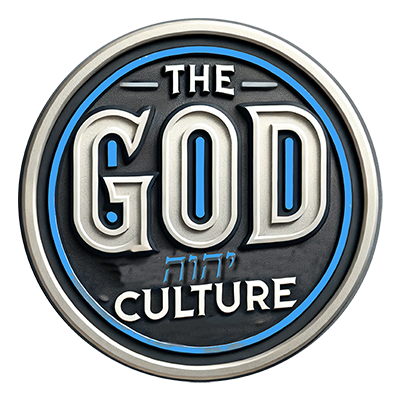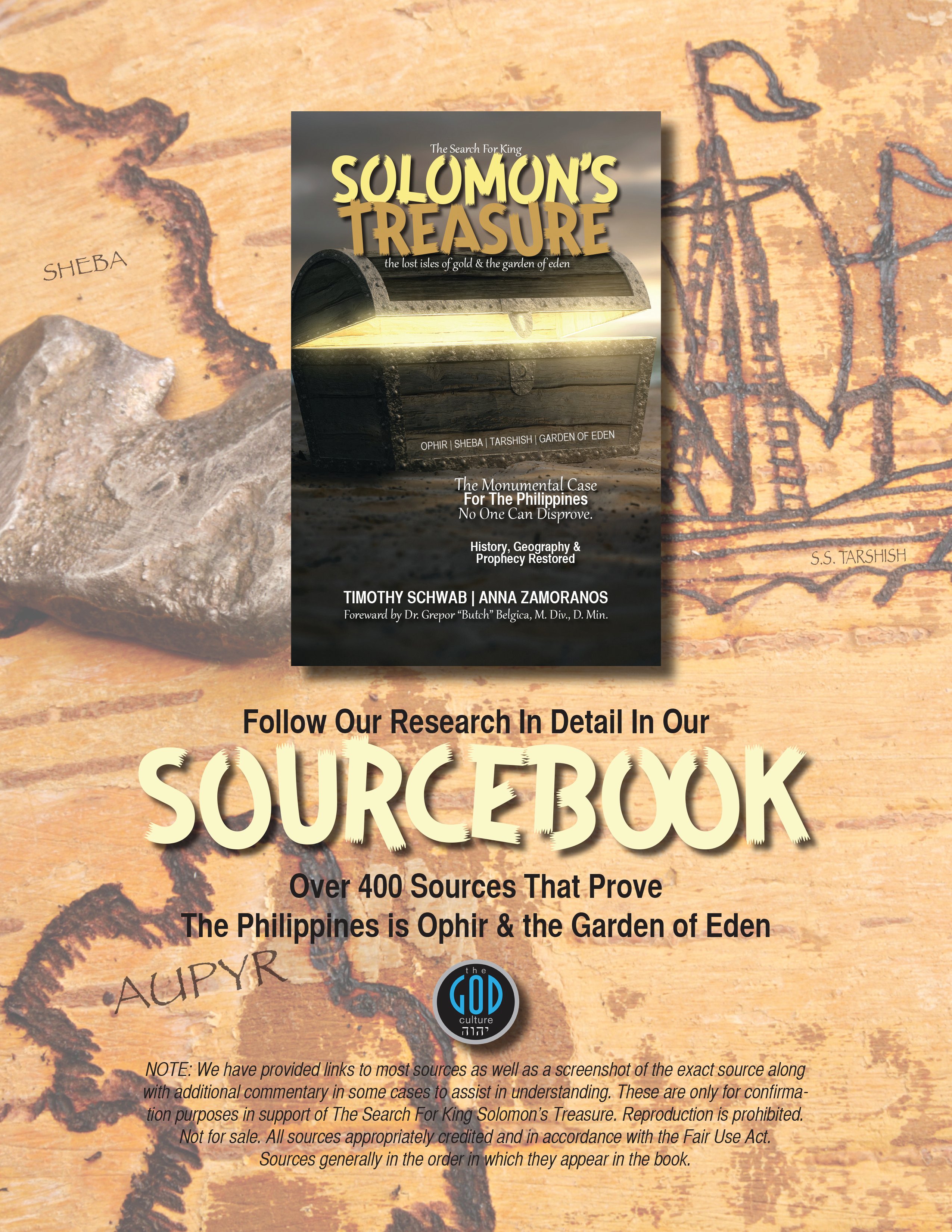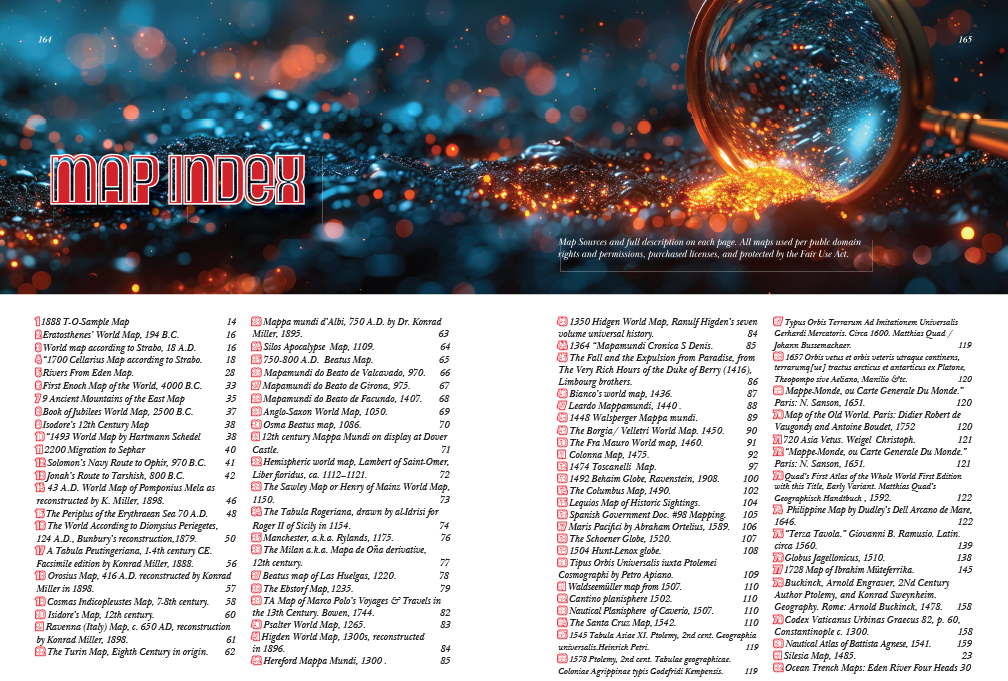PARTIAL SOURCE LIST
This page provides a selection of the diverse sources supporting our research, which demonstrates the Philippines as the historical Ophir and the location of the Garden of Eden. A comprehensive bibliography is included in the back of each of our published books.
Explore Our Complete Sourcebook:
For a more in-depth understanding of our research, download our comprehensive 300-page SOURCEBOOK. This resource includes:
Detailed pages from many of the sources listed below and more.
Direct links to online resources where available.
Full academic credits for all sources.
A Note on the Integrity of Our Research:
We are aware of disinformation efforts that attempt to discredit The God Culture's work. Our commitment to rigorous research is clearly evident in our publications. For example, our first book, The Search for King Solomon's Treasure, features a 16-page bibliography with screenshots of actual sources used. This allows readers to verify our findings page by page, and a comprehensive index is also provided.
Accusations that we do not engage with our sources are demonstrably false and often originate from individuals engaged in online harassment and libel. Our detailed bibliographies, supported by visual evidence and verifiable links, stand as proof of our thorough research process. Such baseless claims are not representative of a genuine pursuit of truth.
Despite these attempts to undermine our work, The God Culture has published extensively on this topic, including four international books and over 100 videos, all built upon a foundation of meticulous research, as evidenced by our publications and the accompanying Sourcebook.
Historic, Academic, and Major Media Sources (English Translations where applicable):
Ancient Texts & Historical Accounts:
The Periplus of the Erythraean Sea
The Life and Voyages of Christopher Columbus (Washington Irving)
The Travels of Marco Polo
Antonio Pigafetta’s Journal (Lord Stanley of Alderley translation)
Pomponius Mela, Chorographia
Flavius Josephus (various works)
The surueye of the vvorld... Dionysius Periegetes
The Voyages and Adventures of Fernando Mendez Pinto, The Portuguese (Henry Cogan translation)
Pliny the Elder, Historia Naturalis
Historia de las islas e indios de Bisayas (Francisco Ignacio Alcina, 1668)
The Discoveries of the World, from Their First Originall Unto the Yeere of our Lord 1555 (António Galvão, Richard Hakluyt translation, 1601)
Origen de los indios de el Nuevo Mundo e Indias Occidentales. (Gregorio García, 1607)
Historia do descobrimento e conqvista da India pelos Portvgveses (Fernão Lopes de Castanheda, 1883 edition)
The Suma Oriental of Tomé Pires (Armando Cortesão translation, 1944)
Purchas his Pilgrimage (Samuel Purchas, 1626)
Magellan’s Voyage Around the World (J.A. Robertson translation, based on Antonio Pigafetta)
Boxer Codex (c. 1590)
Revelation of the Magi (early text)
Academic Publications & Institutions:
The Cambridge Ancient History
Smithsonian Institution
Yale University
The Israel Museum
The Louvre Museum
British Museum
The Philippine Islands (Emma Helen Blair and James Alexander Robertson)
Europe and the Far East (Sir Robert K. Douglas, Cambridge University Press, 1904)
The Journal of Island and Coastal Archaeology
The International Journal of Nautical ArchaeologyThe Institute for Maritime and Ocean Affairs
History of the Philippine Islands (Antonio de Morga, 1609, various translations)
ArcheoSciences Journal
The Carpenter ReportThe Field Museum, Chicago
Philippine Sociological Review
Evolution of Island Mammals
The Journal of History (Ronquillo)
The Philippine Progress (Dr. Austin Craig)
One World Archaeology (Routledge)
National Museum of IranArchives de la Maison Archeologie & Ethnologie
The Journal For Early Modern Cultural Studies
The Complete Dead Sea Scrolls (Geza Vermes)
Man and Culture in Oceania (Ronquillo)
Early Mapping of Southeast Asia (Peter C. Suarez)
NASA/Goddard Space Flight Center
The Stanford Report
University of California Publications in American Archaeology and Ethnology (R.F. Barton)
Eskaya of Bohol: Traces of Hebrew Influence Paving the Way For Easy Christianization of Bohol (Jess Tirol, 1990)
Orientalia Lovaniensia Analecta
The Age of Solomon
University of Cape Town
South Africa Archeological Society
Encyclopaedia Britannica
History of the Phoenician Civilization (George Rawlinson)
Institute of Historical Research
The Ilocos Sur Archaeology Project
Hawai’i Pacific University
Oceanic Institute
Asian Society
Science Magazine
World Atlas
A History of the Philippines (Dr. David P. Barrows)
Asian Studies Journal
The Philippines in the 6th to 16th centuries (Emma H. Blair)
Ginto: History Wrought in Gold (Ramon N. Villegas)
Arts of Asia Magazine (Lazlo Legeza)
Archaeological Studies Program, University of the Philippines Diliman
Chau Ju-Kua: his work on the Chinese and Arab trade in the twelfth and thirteenth centuries (Friedrich Hirth and W.W. Rockhill translation)
The Austronesians: Historical and Comparative Perspectives (Peter Bellwood, James J. Fox, Darrell Tryon)Department of Anthropology, The Australian National University
The Princeton Encyclopedia of Classical Sites
Hindawi African Science JournalArchaeopress
The Columbia Encyclopedia
The American Desk Encyclopedia
Oxford University PressWorld Encyclopedia
Science in the Philippines.
A review by James J. Walsh, Ih.D., M.D.
Christopher Columbus and the participation of the Jews in the Spanish and Portuguese discoveries (Meyer Kayserling, M. Gross translation)
The Jews and the Expansion of Europe to the West, 1450 to 1800 (Paolo Bernardini and Norman Fiering)
Collecion General de Documentos Relativos a las Islas Filipinas (1522)
Philippine Progress Prior to 1898 (Dr. Austin Craig and Conrado Benitez)
The Suma Oriental of Tomé Pires (Armando Cortesão translation, 1944)
University of California Publications in American Archaeology and Ethnology (R.F. Barton)
Eskaya of Bohol: Traces of Hebrew Influence Paving the Way For Easy Christianization of Bohol (Jess Tirol, 1990)
Orientalia Lovaniensia Analecta
The Age of Solomon
University of Cape Town
South Africa Archeological Society
History of the Phoenician Civilization (George Rawlinson)
Institute of Historical Research
The Ilocos Sur Archaeology Project
Hawai’i Pacific University
Oceanic Institute
The Pilgrim’s Muse (Rev. Joseph Thomas, 1816)
Ancient History Encyclopedia
Collins English Dictionary
American Historical Association
Concise Oxford English Dictionary
The Concise Dictionary of World Place Names
South African National Biodiversity Institute
Major Media Outlets:
Philippine Government & Related Agencies:
Bangko Sentral ng Pilipinas (Central Bank of the Philippines)
Philippines Department of Agriculture
Philippines Department of Energy
Philippine Bureau of Customs
Philippine Statistics Authority
Department of Labor and Employment of the Philippines
Philippine Overseas Employment Administration (POEA)
Republic of the Philippines House of Representatives
Philippines Bureau of Export Trade
Primer on the Philippine Minerals Industry (Carlo A. Torres)
Philippine News Agency
Environmental & Scientific Organizations:
Individuals & Other Notable Sources:
William Henry Scott (various historical works)
The Hilti Foundation
Underwater Archaeologist Franck Goddio
Moussons (Social Science Research Journal)
The Boxer Codex (Lazlo Legeza commentary)
Encyclopedic Dictionary of Archaeology
Chau Ju-Kua (annotated translations)
Philippine Supreme Court Justice Antonio T. Carpio (various writings on Philippine history and maritime law)
Professor Adrian Horridge (research on ancient navigation)
William Larousse (linguistic studies)
Godofredo U. Stuart Jr., M.D. (medical and historical perspectives)
Rabi-Kohan Shalomim Y. HaLevi, Ph. D, D. Div., O.R. Thrpst. S.A.C.
Dr Alan P Newman (historical research)
Antonio J. Montalvan II, Ph.D., Mindanao Anthropologist and Ethnohistorian
Chaim Ben Torah (Hebrew studies)
Jewish Virtual Library
Ancient Hebrew Research Center (Jeff A. Benner)
Dr. Steven D. Fraade (religious studies)
Dr. Charles F. Stanley (theological perspectives)
Some of the Hebrew Definitions from:
Pealim Hebrew Lexicon
Abarim Publications
Strong’s Concordance
Gesenius’ Hebrew-Chaldee Lexicon
Strong’s Exhaustive Concordance
Thayer’s Hebrew and Greek Lexicon
Brown-Driver-Briggs Hebrew and English LexiconEaston’s Bible Dictionary
International Standard Bible Encyclopedia
Smith’s Bible Dictionary
Hitchcock’s Dictionary of Bible Names
King James Bible Dictionary
ATS Bible Dictionary
Contextualising the Teaching of Biblical Hebrew (Stephen H. Levinsohn, Ph.D)
McMaster Journal of Theology and MinistryLinguistics (Cotterell and Turner)
Balashon - Hebrew Language Detective
The Johns Hopkins University Press (George A. Shipley, The Vocabulary of Jewish Babylonian Aramaic)
Encyclopedia Judaica
Ancient Hebrew Research Center (Benner)
Some of the Historic Extra-Biblical Books:



